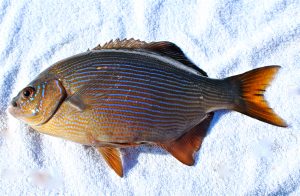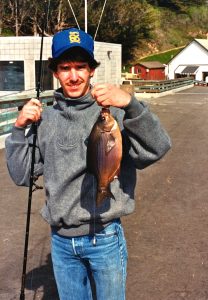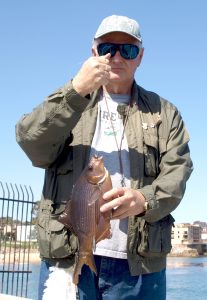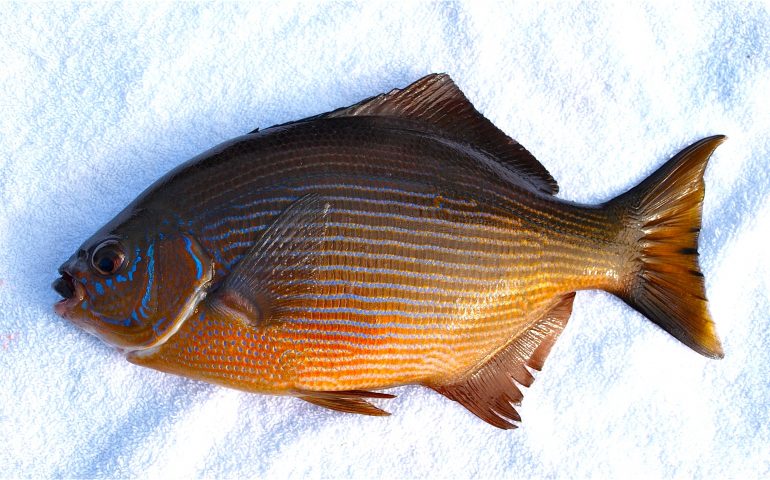Surfperches/Seaperches: Family Embiotocidae
Species: Embiotoca lateralis (Agassiz, 1854); from the Greek root words embios (living) and tocos (to bring forth) and the Latin word lateralis (lateral, due to their blue stripes).
Alternate Names: Striped surfperch, rainbow perch, blue perch, striped surf fish. Early-day names included squawfish and crugnoli. In Mexico called mojarra azul or perca.
Identification: Striped seaperch have narrow orange and blue longitudinal stripes with blue spots on their head. Their dorsal spines are low and their body is deep and compressed. Dark and light color variations.
Size: To 16.4 inches; most caught from piers are 9-13 inches long. The California record fish weighed 2 lb 11 oz and was caught at King Salmon, Humboldt Co. in 2019. The World Record fish was 1 Lb 12 oz and taken in Tiburon, CA in 2016; a second fish the same size was taken in Westport, Washington in 2016.

Range: Arrecife Sacramento, central Baja California, to Klakas Inlet in southeastern Alaska. Common from northern Channel Islands, southern California, to Haida Gwaii, British Columbia. Uncommon to most of southern Caliornia but common again in northern Baja California.
Habitat: Typically found in shallow-water, rocky-shore area, most often near the the bottom. Recorded to a depth of 312 feet.
Piers: Common at central and northern California piers situated near rocks. Best bets: Cayucos Pier, Santa Cruz Wharf, San Francisco Municipal Pier, Elephant Rock Pier, Point Arena Pier, Trinidad Pier, and Citizens Dock in Crescent City. The Point Arena Pier is undoubtedly the top pier in the state for striped seaperch; late winter to spring will almost always yield perch and most are fairly large fish.
Shoreline: One of the main catches for rocky shore anglers in central and northern California.
Boats: An inshore species rarely taken by boaters.

Striped seaperch from the Point Arena Pier
Bait and Tackle: A high/low rigging is most commonly used for these large perch. Use a size 6 or 4 hook, a weight heavy enough to keep your bait stationary, and fish on the bottom near the pier. Striped perch most commonly travel in schools; if one is caught more are probably around. These perch will often make a sharp first strike without hooking themselves. Be patient, they will return and often keep pecking at the bait until hooked. The best bait depends on location. North of San Francisco the best bait is fresh mussels, raw shrimp (small pieces), live rock crabs, live pile worms, frozen tube worms and crab backs; in the Bay Area live grass shrimp and fresh mussels are the top baits.
Food Value: Large enough to eat with flesh that is mild in flavor with small flakes and soft texture. They taste best during the non-spawning season, are low in fat content, and can be cooked using most methods.
Comments: Although these perch are often large, some anglers do not like to fish for them. In the spring, the largest perch will often be females loaded with live young; when landed, the fish will start to give birth and the angler will be faced with the question of what to do with dozens of small live baby perch. A few anglers save them as bait, many throw them in the water, and some simply refuse to keep the mother perch preferring to let nature work its answer to the question of survival.

Mike Granat and a striped seaperch from the Coast Guard Pier in Monterey
